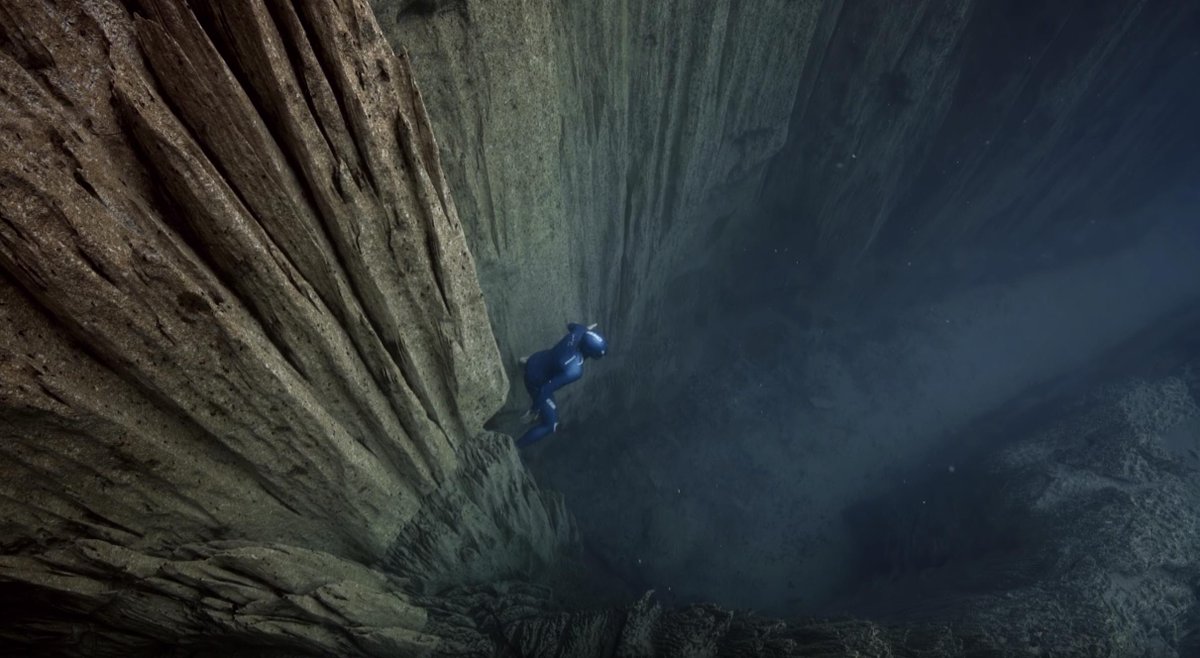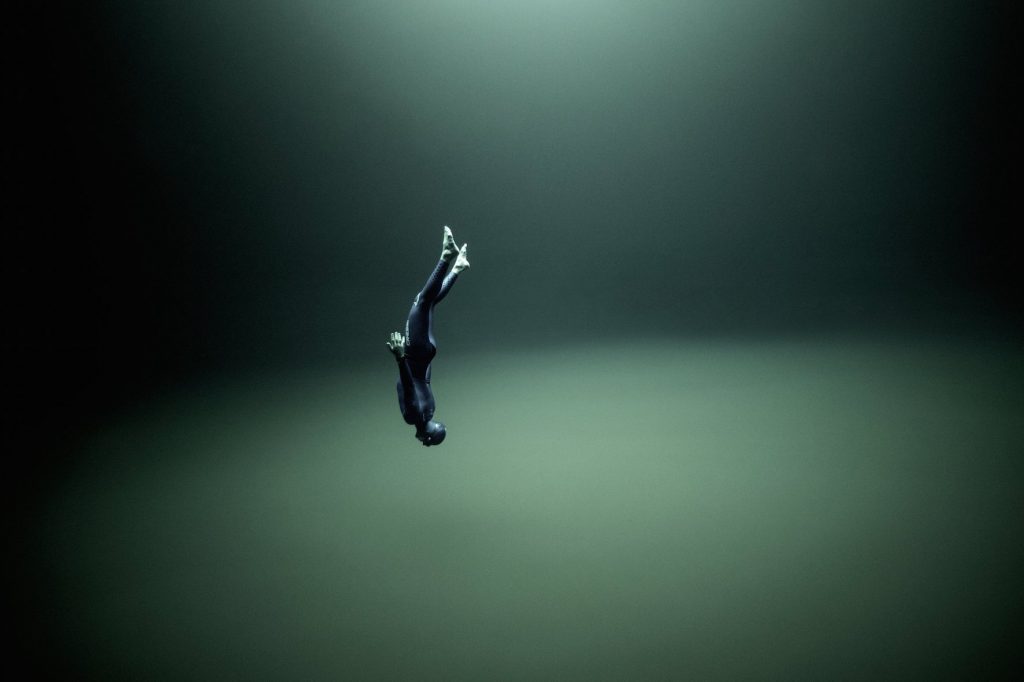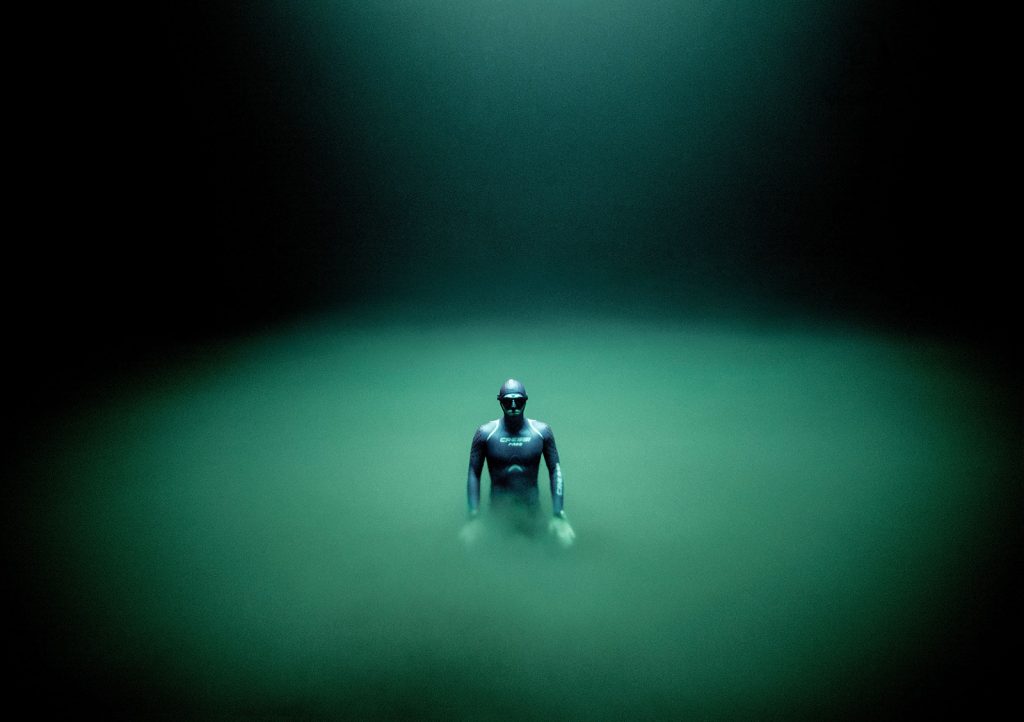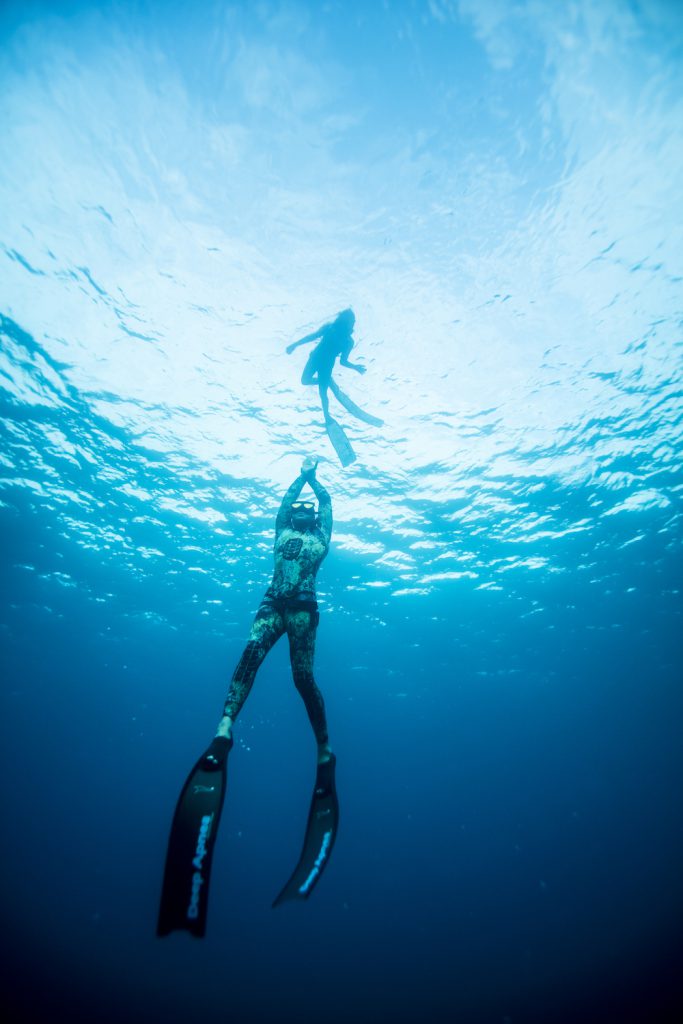
This freediving couple reveals the world underwater like never before.



Their short film ‘One Breath Around the World’ brings an artistic edge to the dangerous sport.
How long can you hold your breath? One minute? Two? Five? For freedivers, this calculation is a matter of life and death. If you are relying solely on one breath, your window to explore underwater landscapes is bound by your lung capacity. On the flip side, you are unencumbered by the weight, noise, and constraints of scuba gear.
French freediving champions Guillaume Néry and Julie Gautier are no strangers to the possibilities and dangers of freediving—the extreme sport of deep water diving without breathing apparatus. Both are world-record holders, and both know freedivers who died after pushing too deep or staying down too long.
At the end of their competitive freediving careers, the long-time partners, who have a daughter together, decided to turn to filmmaking full-time. They wanted to try and convey the unique, oxygen-less exhilaration that had become their life’s passion. As Néry runs, dives, and flips across the seafloor on a single breath (he can hold his breath for more than seven minutes), cinematographer Gautier is right there herself, also without breathing assistance, capturing every motion.
In their new short film, One Breath Around the World, Néry, 37, and Gautier, 39, take viewers on an underwater odyssey across the globe. Shooting in locations from Mauritius to Mexico to Japan and many stops in between, Néry and Gautier draw on their extensive experience to explore submerged ruins, swim beneath a thick sheet of ice, mingle with a pod of sleeping sperm whales. In the process, they capture mesmerizing images of parts of the planet unseen by most of its human inhabitants.
We spoke to Néry and Gautier to learn more about their approach and process, as well as how they plan to apply their novel filmmaking style in the future.
What drew you both to freediving in the first place?
Guillaume Néry : I grew up in Nice, by the Mediterranean Sea. As a kid, being close to the sea meant that every summer you spent a lot of time playing in the sea. And to me, it was just that, no more. I loved to have a mask and a pair of fins, and I loved to leave the surface and snorkel and dive a few meters, but it was just a game. My parents were much more dedicated to mountains. In Nice, we have beautiful and high mountains very close to the city. I did a lot of hiking with them. It opened my love to big spaces and nature.
Julie Gautier: I was born on Reunion Island, and my father was a spearfisher. So, from 11 years old I’ve been spearfishing. I was using my breath to catch fish and to eat well. But I started pure freediving when I was 18. I discovered that it was a real discipline of sport, a competitive sport. So, of course, I tried it. And because I believed I was quite good at it, I started doing competitions. Eventually I broke three French records. And yeah, I went all around the world with Guillaume to do competitions.
As you were training to freedive competitively, were you motivated more by having access to hard-to-reach underwater places or was it more about proving to yourself that you could overcome the physical challenge?
GN: It was a constant evolution. I discovered early on that going in the deep on breath hold was something extraordinary and was a very pure way to access the unknown. And what was at the beginning just a game to push my limits became then a real adventure in a new place. So with my capacities, I realized that I could be able to dive and to discover the underwater world, and on my own, I could dive where people normally use tanks to dive. And I was fascinated by this idea that if I train my body and my mind just with my natural skills, I can go where almost nobody can go.
When I realized what that exploration meant to me, it became a combined quest, a quest to conform my body and to really become an aquatic human. When I realized that I had the capacity with a lot of training to become one of the deepest freedivers in the world, and then it became kind of a dream to become the deepest guy on the planet. It’s not an ego thing, and it’s not only about sports. It’s about going in a place where you know you’re the first, and it’s about much more than the numbers.
What prompted the shift to filmmaking?
JG: We were in the Bahamas, Guillaume was competing for this championship in 2010, and I joined him there. And we had this underwater camera in housing because, you know Guillaume, he loves his photography. A friend of ours had the same exact camera, and he showed us the movie he made with it. We thought it was beautiful and said, “Oh, my God. We have the same device, maybe we can make something.” So Guillaume said, “Oh, I have an idea. I would love to dive into this beautiful blue hole we have in the Bahamas because we’re free in the afternoon. Maybe we can take the camera and film me.”
What we found quite interesting was the chance to show another side of freediving, not only about performance but just more about the feeling of it underwater. I was quite scared because I’d never touched a camera in my life. But, Guillaume knew some and he told me, “Yeah. You push this button and you turn and you see what’s happening on the image and if you like it, you know it’s okay.” So, it’s how it all started. We made our Freefall video just thinking we’re going make a nice vacation movie.
GN: When we did the first movies, the reason why it touched so many people is because we really tried to show freediving in a new way. To explore a new way to interact with the water. Walking, running, jumping, flying. That was something that had never been done before, showing the link between humans and the water in this way.
Filming while freediving presents its own unique challenges and opportunities.How have you adapted your technique?
JG: We just started filming on breath hold, and we found out that it was making our images special because, of course, also I’m so free in the water. I can go so fast. I can follow Guillaume wherever he goes. He asked me to do this quite amazing shot in Freefall where I start behind him and I go in front and I turn around; that’s impossible to do with the scuba.
Sometimes I’ll work with a director of photography who is on scuba. We need to plan a lot of what we’re going to be shooting. To me this is less organic, you know, a bit less magic happening because it’s all planned. And what I love doing in freediving is that when I’m down there I just can decide, “Okay. Let’s do something else,” and that’s really powerful.
GN: The breath hold time is really an issue because when you’re filming like that, you’re not focused on being relaxed and saving energy. You are dedicated to the shots you want to get, so there’s a lot of tension, using a lot of energy. Julie’s using a lot of energy because she has to be very steady to get steady shots. I need to dive using mostly empty lungs. I need to do some actions, like running, climbing, so I’m using a lot of oxygen. And sometimes, you forget about the breath hold because you really want to get the perfect shots.
When you just freedive, you think about body position and your relaxation to maximize the time in the water, but when you’re shooting, the priority is to get the most beautiful shot. So sometimes, the risk is that if you want to stay a few more seconds because everything is perfect. The light is perfect, the position of the animal is perfect. So it’s very important to have very good assistance and to have very experienced safety freedivers that can help us in case of a problem.
Where did the idea for One Breath Around the World come from?
GN: In 2014, five years ago, I started to have this idea that I wanted to tell the story of an odyssey. I’ve always been fascinated by the people who are traveling alone by themselves, like crossing continents, just walking. For example, when I was a teenager and young, I was reading books about people who were leaving Paris going to Beijing, or Japan, just walking, and I found that fascinating. And then in 2014, I had this idea, let’s try to think about the trips we could do on land, walking trips, but underwater.
JG: It’s been a quite long process. It’s really Guillaume’s idea. He had it a long time ago and we were sharing about how to put it together. We have a daughter, and we wanted for her to also be a nice experience and not just leaving her at home and go shooting, and come back. You know, meeting these wonderful animals and seeing these beautiful places was also an experience we wanted to share with her.
How were you able to film the unforgettable encounter with the sperm whales?
JG: We saw that it was magical to be able to work in freediving because we could approach the animals a lot more easily, a lot more quietly. And, which is why we were able to film this amazing image of the sperm whales sleeping vertically in the water and having Guillaume just swimming behind them and me filming in front and they didn’t wake up. Why? Just because we came very quietly. I was going down just on breath holds, using my fins, not making sound, not making bubbles, being very efficient.
GN: If I could get crazy images with the sperm whale, I know I could build a story around it. So we started with the sperm whales, we stayed seven days in Mauritius islands, and we got the perfect moment and images. After that, I was confident. I was like, “Okay, we can do it, so let’s make it.”
Now that your film is out in the world, what does the future hold?
JG: I think it’s time for us now to get involved into making people understand that we are living a quite extreme period of our human life and that it’s time to act and to be responsible for what is happening. You don’t have to go all around the world and to crowd the planet to see beautiful things. So we would love to try for the next one to maybe do something around Nice. And knowing the Mediterranean Sea, there’s a lot of things to see, a lot of nice, underwater landscapes, there are many mammals possible. And we would like to show that we can make a movie without traveling, without taking planes. https://www.nationalgeographic.com/adventure/article/freedivers-guillaume-nery-julie-gautier-one-breath-around-world
——-
NEW FILM: Our new short film (12 min) is finally out. Turn out the light, put your headphones and freedive with me around the world This great adventure was possible thanks to the support of a great team * Julie Gautier, my wife. One more time she did an AMAZING work. Everything she is shooting with her camera become magic. Of course, she shot as usual all the images on breath hold! * Almo Film and his boss Morgan Le Faucheur for his support as co producer of the project during the post production process. * Ben Nardini, the multi task guy: Editing, Sound design and drone pilot! * Guillaume Ferran, the magician behind the original soundtrack * Arthur Paux, as usual, who made the beautiful color correction * Leonard Mercier added a great touch with the compositing and stabilization * Xavier Fulbert / Ideocast made the sound mix * Franck Seguin the fantastic photographer who made a book edited by Glenat #apleinsouffle Of course, nothing would be possible without the safety and logistic support from our friends / freedivers around the world: Wilfried Souza, Nico, Dolswim, Julien Borde, Pranamaya Freediving, Rodrigo Salsas, Louis Pasquer, Suzanne Lim, Luke Schroeder, Catalin Craciun, Freediving Coron, Carlo Navarro, MJ Paula, Odessa Bugarin, Ryuzo Shinomiya, Tomoka Tsukakoshi, Kikachiro and Shotaro Maja, Denis Grosmaire, Moorea freediving, Sane Richmond, Tetamanu Village et Diving, Patea Alexandre, Tevai Malinowski, Monique Daudon, Antero Joki, Maria Hellinger, Kiki Bosch Supported by Cressi, Nauticam, Department of Tourism – Philippines, Bluenery Special thanks: Clovis Kerville, Mauritius Film Development Corporation, René Heuzey, Divers’ Ocean, Juli and Salomon, Imam El Dio, Daniel Minnella, Ville de Nice, Véronique El Bahjaoui, Hélène De Tayrac-Senik, Bastien Soleil Special thanks to The Oceania Project for the whale song at the end: soundcloud.com/iwhales
Travel beyond your wildest dreams…
https://www.nationalgeographic.com/expeditions/?cmpid=int_org=ngp::int_mc=website::int_src=ngp::int_cmp=exp_dotcom_inpage::int_add=ngpexp-inpagepromo
